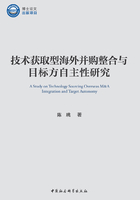
Abstract
Technology sourcing overseas M&A as a channel to enhance the technological capability of an enterprise and achieve synergy,is nowadays playing a more and more important role in China’s outward foreign direct investment. For the many Chinese acquiring enterprises,completing the M&A is just a start;achieving the expected synergy effect still requires the effective recombination and integration of the resources and technologies of the two merging parties. M&A failure caused by inappropriate integration is not rare in practice,so how to choose and implement the optimal integration strategy to better achieve post-merger synergy is a realistic question to Chinese acquiring enterprises,also a research focus to scholars.
From the perspective of resource similarity and complementarity,this book builds the theory of the integration and target autonomy in technology sourcing overseas M&A,and tests the theoretical hypotheses using a variety of research methods such as mathematical model building,simulation experiment,comparative empirical analyses,and case analyses. Based on resource similarity,resource complementarity,and their interaction effect,we emphasize that integration strategy—including the choices of integration degree and target autonomy—should be matched with the resource relatedness of the two merging parties to optimize post-merger synergy,and we also discuss the influence of institutional distance on the effectiveness of the matching pattern,trying to provide some theoretical and practical implication for Chinese acquiring enterprises in technology sourcing overseas M&A.
In terms of theoretical promotion in this field,this book mainly works at the following two aspects:Firstly,from the perspective of resource similarity and complementarity and their interaction effect,this book examines the matching between resource relatedness and post-merger integration strategy,and considers the impact of this matching on post-merger synergy further,thus forms a coherent logical chain considering the relationship between the three and constructs an improved theoretical framework. Secondly,this book puts special emphasis on the institutional factors in overseas M&A that are different from those of domestic M&A and examines the impact of institutional distance between home and host countries on the effectiveness of the matching pattern between resource relatedness and integration strategy by proposing the optimal integration degree and target autonomy selection under different situations of institutional distance in order to maximize the synergy effect after M&A. We organically combine the perspective of institutional theory with the perspective of resource-based theory,forming a more comprehensive study of overseas M&A integration.
Meanwhile,the research conclusion of this book also has some practical guiding significance for the integration decision-making of Chinese acquiring enterprises in technology sourcing overseas M&A:Firstly,managers should fully understand the significance of integration to the success of technology sourcing overseas M&A. Chinese acquiring enterprises should continuously accumulate experience in practice,pay attention to the construction and improvement of the integration capability of overseas M&A,and cultivate and organize excellent integration management teams. Secondly,managers should be aware that there is no one fixed integration pattern applicable to all types of technology sourcing overseas M&A. Chinese acquiring enterprises should collect information before M&A and evaluate all aspects of overseas targets as well as the external political,economic,social and legal environment of the overseas M&A prudently and fully,so as to make the optimal M&A integration decision on the basis of accurate information to achieve best synergy.
Keywords:Technology sourcing overseas M&A;Integration degree;Target autonomy;Resource similarity;Resource complementarity;Institutional distance